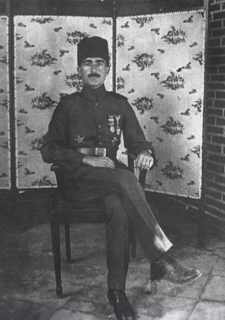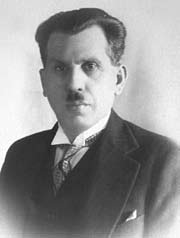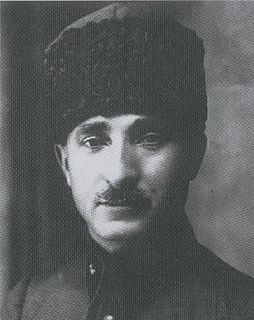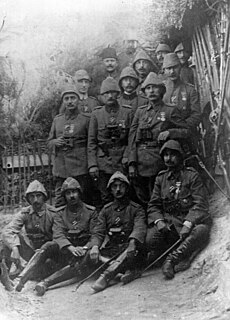World War I
Order of Battle, June 1915
The corps was formed as the Right Wing Group of the Mahmut Kâmil Pasha's Third Army on June 7, 1915 and commanded by Halil Bey. In a rearrangement of operational field commands, Mahmut Kâmil Pasha redesigned this unit as the Provisional Halil Corps. [1]

The Third Army was originally established in the Balkans and later defended the northeastern provinces of the Ottoman Empire. Its initial headquarters was at Salonica, where it formed the core of the military forces that supported the Young Turk Revolution of 1908. Many of its officers who participated in the Revolution, including Enver Pasha and Mustafa Kemal Atatürk, rose to fame and power.

Halil Kut was an Ottoman-born Turkish regional governor and military commander. Halil Pasha was the uncle of Enver Pasha, who was the War Minister during World War I.
- Right Wing Group (Caucasus, Commander: Kaymakam Halil Bey -> Mirliva Abdülkerim Pasha since July 19, 1915)
The 5th Expeditionary Force of the Ottoman Empire was one of the expeditionary forces of the Ottoman Army.

Bekir Sami Günsav was a Turkish career officer, who served in the Ottoman Army and the Turkish Army.

Kâzım Fikri Özalp was a Turkish military officer, politician, and one of the leading figures in the Turkish War of Independence.
Mirliva or Mîr-i livâ was a military rank of the Ottoman Army and Navy. It corresponds to a Major General in the modern Turkish Army. Mirliva is a compound word composed of Mir (commander) and Liva. The rank was junior to the Ferik and superior to the rank Miralay in the Ottoman Army and the pre-1934 Turkish Army.
The 1st Expeditionary Force of the Ottoman Empire was one of the expeditionary forces of the Ottoman Army.

Ali İhsan Sâbis was the commander for the Sixth Army of the Ottoman Empire. After the war he was exiled to Malta by the British occupation forces. After returning to Turkey, he was appointed to the commandship of the First Army of Turkey. But shortly before the battle of Dumlupınar, he retired.
Order of Battle, Late Summer 1915
On September 20, 1915, the Provisional Halil Corps was re-designated as the XVIII Corps of the Ottoman Army. [2] In late Summer 1915, the corps was structured as follows: [5]
Order of Battle, January 1916
In January 1916, the corps was structured as follows: [6]
- XVIII Corps (Mesopotamia)
Order of Battle, August 1916
In August 1916, the corps was structured as follows: [7]
- XVIII Corps (Mesopotamia)
Order of Battle, December 1916
In December 1916, the corps was structured as follows: [8]
- XVIII Corps (Mesopotamia)
- 45th Division, 51st Division, 52nd Division
Order of Battle, August 1917, January 1918
In August 1917, January 1918, the corps was structured as follows: [9]
- XVIII Corps (Mesopotamia)
Order of Battle, September 1918
In November 1918, the corps was structured as follows: [10]
- XVIII Corps (Mesopotamia)
The First Army or First Guards Army of the Ottoman Empire was one of the field armies of the Ottoman Army. It was formed in the middle 19th century during Ottoman military reforms.
The I Corps of the Ottoman Empire was one of the corps of the Ottoman Army. It was formed in the early 20th century during Ottoman military reforms.
The II Corps of the Ottoman Empire was one of the corps of the Ottoman Army. It was formed in the early 20th century during Ottoman military reforms.

The III Corps of the Ottoman Empire was one of the corps of the Ottoman Army. It was formed in the early 20th century during Ottoman military reforms.
The IV Corps of the Ottoman Empire was one of the corps of the Ottoman Army. It was formed in the early 20th century during Ottoman military reforms. It was disbanded at the end of World War I.
The V Corps of the Ottoman Empire was one of the corps of the Ottoman Army. It was formed in the early 20th century during Ottoman military reforms.
The VI Corps of the Ottoman Empire was one of the corps of the Ottoman Army. It was formed in the early 20th century during Ottoman military reforms. It is most notable for its participation in the offensive phase of the 1916 Romanian Campaign of World War I, where it was involved in heavy action all throughout the five months, inflicting heavy casualties on the Russo-Romanians and breaking through the Allied lines in several key areas. Additionally the VI Corps took 8,512 prisoners in Romania, including 6,512 Russians and 2,000 Romanians.
The VII Corps of the Ottoman Empire was one of the corps of the Ottoman Army. It was formed in the early 20th century during Ottoman military reforms.
The VIII Corps of the Ottoman Empire was one of the corps of the Ottoman Army. It was formed in the early 20th century during Ottoman military reforms.
The XII Corps of the Ottoman Empire was one of the corps of the Ottoman Army. It was formed in the early 20th century during Ottoman military reforms.

The XIII Corps of the Ottoman Empire was one of the corps of the Ottoman Army. It was formed in the early 20th century during Ottoman military reforms.

The Sixth Army of the Ottoman Empire was one of the field armies of the Ottoman Army. It was formed in the middle 19th century during Ottoman military reforms.
The Eastern Army Group of the Ottoman Empire was one of the army groups of the Ottoman Army. It was formed during World War I.

The Yildirim Army Group or Thunderbolt Army Group of the Ottoman Empire or Army Group F was an Army Group of the Ottoman Army during World War I. While being an Ottoman unit; it also contained the German Asia Corps.

The XV Corps of the Ottoman Empire was one of the corps of the Ottoman Army. It was formed during World War I.
The XVII Corps of the Ottoman Empire was one of the corps of the Ottoman Army. It was formed during World War I.
The XX Corps of the Ottoman Empire was one of the corps of the Ottoman Army. It was formed during World War I.
The XXI Corps of the Ottoman Empire was one of the corps of the Ottoman Army. It was formed during World War I.
The XXII Corps of the Ottoman Empire was one of the corps of the Ottoman Army. It was formed during World War I.
The Iraq Area Command or Iraq Regional Command of the Ottoman Empire was one of the military formation of the Ottoman Army. It was formed in Iraq in the initial stage of World War I.
This page is based on this
Wikipedia article Text is available under the
CC BY-SA 4.0 license; additional terms may apply.
Images, videos and audio are available under their respective licenses.












